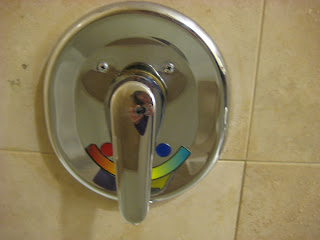Friday, August 3, 2012
Easter Island head (sort of)
...but yes, he is really jut a pump.
Friday, July 13, 2012
Dog-fan
Sunday, July 8, 2012
Saturday, July 7, 2012
Angry speaker!
Friday, June 29, 2012
Funny face
Big mouth pottery
Thursday, June 28, 2012
The happy-faced spider
Tuesday, June 19, 2012
Friday, June 8, 2012
Blue-nosed bucket
Friday, June 1, 2012
Scary helmet
Sunday, May 20, 2012
Friday, March 16, 2012
Saturday, February 4, 2012
Spooky, happy, octopus house thing

Ugly But Happy!

The Black Swan

Wednesday, January 11, 2012
The big-eared angry pepper!
Tuesday, January 10, 2012
A ghost in the water...(thanks Lydie)
At last, recognition!
How the Brain Spots Faces
- By Wired UK
- January 10, 2012 |
- 10:00 am |
By Mark Brown, Wired UK
Our brains are made to find faces. In fact, they’re so good at picking out human-like mugs we sometimes see them in a jumble of rocks, a bilious cloud of volcanic ash or some craters on the Moon.
Neuroscientists from the Massachusetts Institute of Technology wanted to investigate how the brain decides exactly what is and is not a face. Earlier studies have shown that the fusiform gyrus, located on the brain’s underside, responds to face-like shapes — but how does it sort flesh from rock?
Pawan Sinha, professor of brain and cognitive sciences at MIT, and students created a procession of images ranging from those that look nothing like faces to genuine faces. For the ones in the middle — structures, formations, smudges and shapes that give us a pareidolic reaction that causes us to see a face — they used photographs that machine vision systems had falsely tagged as faces.
By doing a series of one-to-one comparisons, the human observers rated how face-like each of the images were. And while the subjects sorted out the photographs, functional magnetic resonance imaging (fMRI) was used to scan their brains and look for activity.
The neuroscientists found different activity patterns on each side of the brain. On the left, the activity patterns changed very gradually as images became more like faces and there was no clear distinction between faces and non-faces. The left side would flare if someone was looking at a human or an eerily face-like formation of rocks.
But on the right side, activation patterns in the fusiform gyrus were completely different between genuine human faces and face-like optical illusions. There was no fooling the right side of the brain, no matter how much they resembled a face.
The researchers could conclude that the left side of the brain ranks images on a scale of how face-like they are.The right side makes the categorical distinction whether or not it’s a human face.
The left side of the fusiform gyrus actually flared up before the right side supporting the hypothesis that the left side does its job first and then passes information on to the right side. (Though because of the sluggishness of fMRI signals, which rely on blood-flow changes, the timing does not yet constitute definitive evidence).
“The left does the initial heavy lifting,” Sinha says. “It tries to determine how face-like is a pattern, without making the final decision on whether I’m going to call it a face.” The right’s job is to make the final call.
This clear distribution of labour is one of the first known examples of the left and right sides of the brain taking on different roles in high-level visual-processing tasks.



















